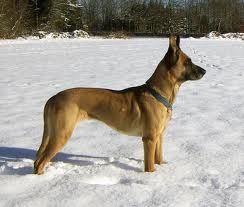History
The Belgian Malinois originated in the Dutch-speaking city of Mechelen, in Flanders, Belgium, and the breed has been recognized since the late nineteenth century. They were first registered in 1901. Although classified as a herding dog, the Malinois is an excellent guard dog and all-round working dog.
The Belgian Malinois is registered as a separate breed by the American Kennel Club (AKC) but in most other countries is considered one of four breeds of Belgian Shepherd Dog. The other varieties are the Groenendael, Laekenois and Tervuren. They are very popular in their home country of Belgium and are gaining popularity in many European countries and the United States. In several countries, they are now being used as working dogs along with German Shepherds and are sometimes considered to be even better in these roles than German Shepherds due to being lighter and faster. They can also be picked up relatively easily, which is not the case with the larger German Shepherd.
Appearance
The Malinois is a square, compact and sleek looking dog with a straight back and a deep chest. They are bred primarily as working dogs, rather than show dogs, thus their appearance can vary quite widely. The coloring is very much like that of a German Shepherd, and the Malinois is often mistaken for a German Shepherd. However, the Malinois is smaller and has a more streamlined appearance. The German Shepherd would be considered a large breed dog and the Malinois a medium breed. Their weight can range from 24 to 34 kilograms, with the female being smaller than the male.
The Malinois has a short, water-proof, double coat and should not be bathed too often as this will strip the coat of its waterproofing. They shed twice a year, but there will be some shedding all year round due to the double coat. The Malinois does not require much grooming, just brushing a few times a week. The coloring of the base coat ranges from fawn to mahogany with a lighter underside and some black tipping to the hairs. The face has a black mask, and the ears are black and erect. The expression is alert and intelligent with almond-shaped brown eyes. The paws are small and round.
Temperament
The Belgian Malinois is a working dog and is known for its enormous levels of energy. It needs a job to do. These dogs are very devoted to their family and make superb guard dogs, being both alert and loyal. They tend to become fiercely attached to just one or two people and are reserved with strangers. They can also exhibit shyness and aggression if not well socialized when young, so this is a must. They do best with a larger property but can be kept in a small one if the owner is prepared to provide plenty of exercise and training. They have a high prey drive and can easily become neurotic or destructive if not given enough to do.
This breed is extremely intelligent and curious and can learn just about any task quickly and well. They are sensitive dogs who do not respond well to harsh training methods. They are bred to work closely with their handlers and so are easy to train and enjoy their training very much. As such, they have become the dog of choice in many working capacities, including the police and the military. They also excel at sporting disciplines such as obedience, flyball, agility, tracking and Schutzhund. These dogs do best with an experienced owner looking for a working dog as well as a pet. When they are well socialized and their needs are met, they can make very suitable family dogs. They do not do well kept outside or in kennels as they enjoy the company of their owners. Their need for exercise, training and company makes them rather demanding dogs, and they need owners who are prepared to devote plenty of time to them. They like to go everywhere with their owners whenever possible.
Health
The Belgian Malinois is considered to be a very healthy breed overall. Health problems that may arise include dysplasia of the hips or sometimes the elbows and eye problems such as cataracts or progressive retinal atrophy. The average lifespan is 12 to 14 years.

 The Best Dog Crates for Labradors in 2017
The Best Dog Crates for Labradors in 2017